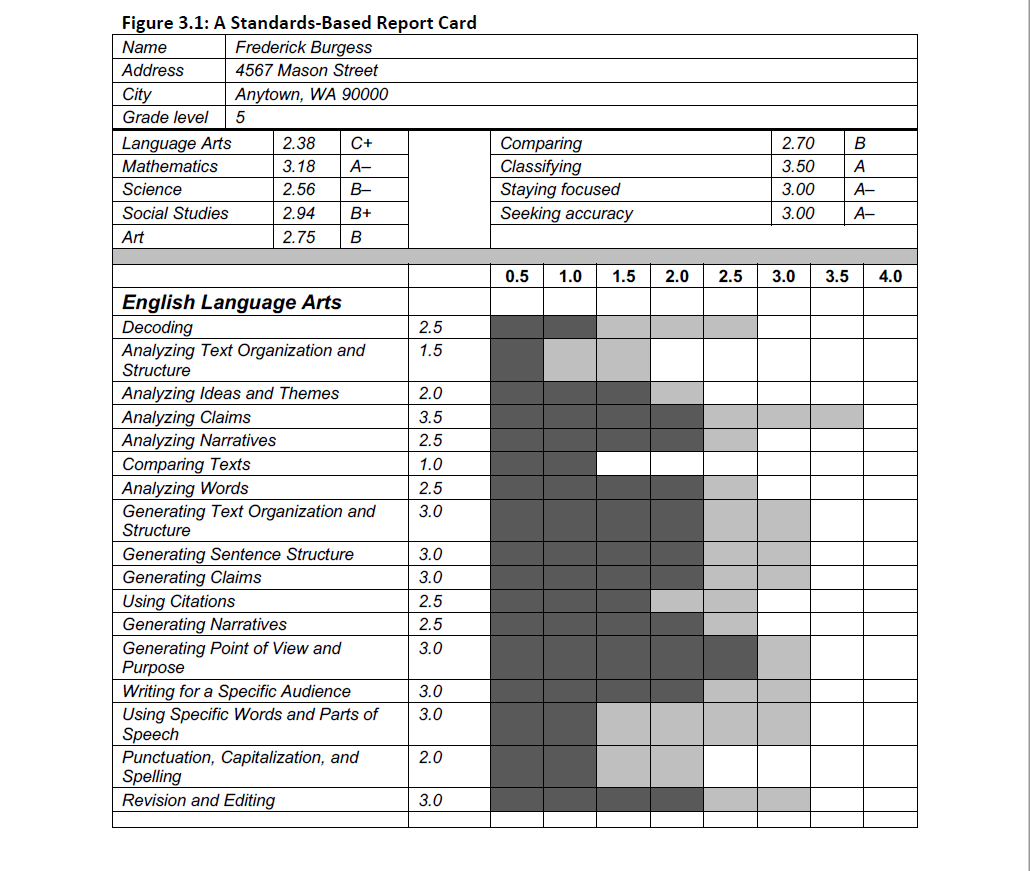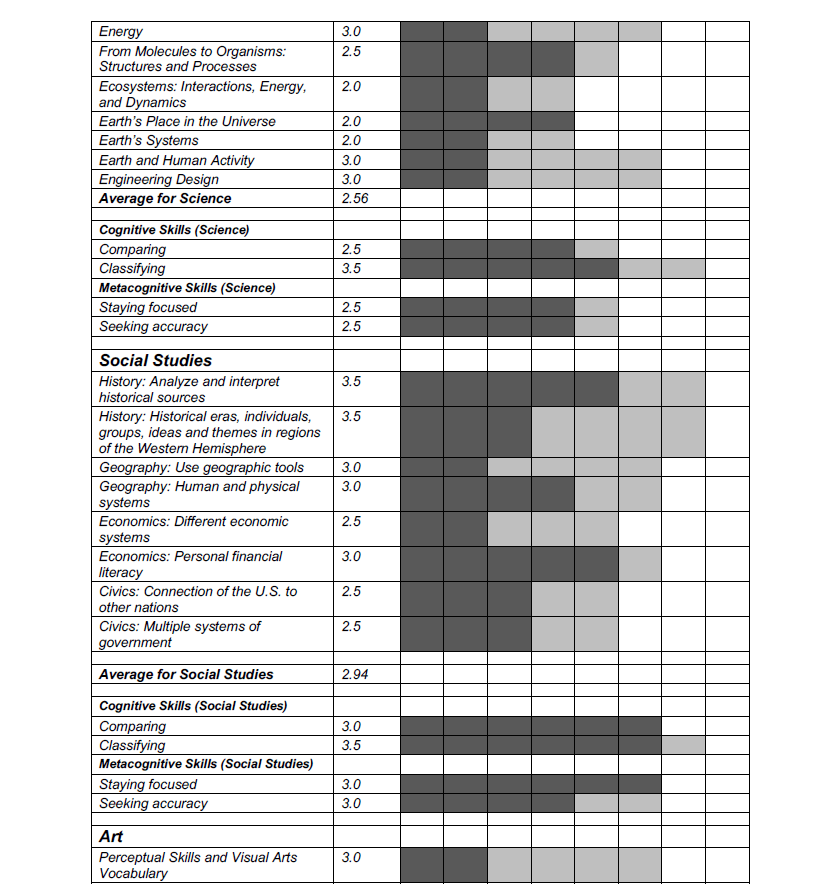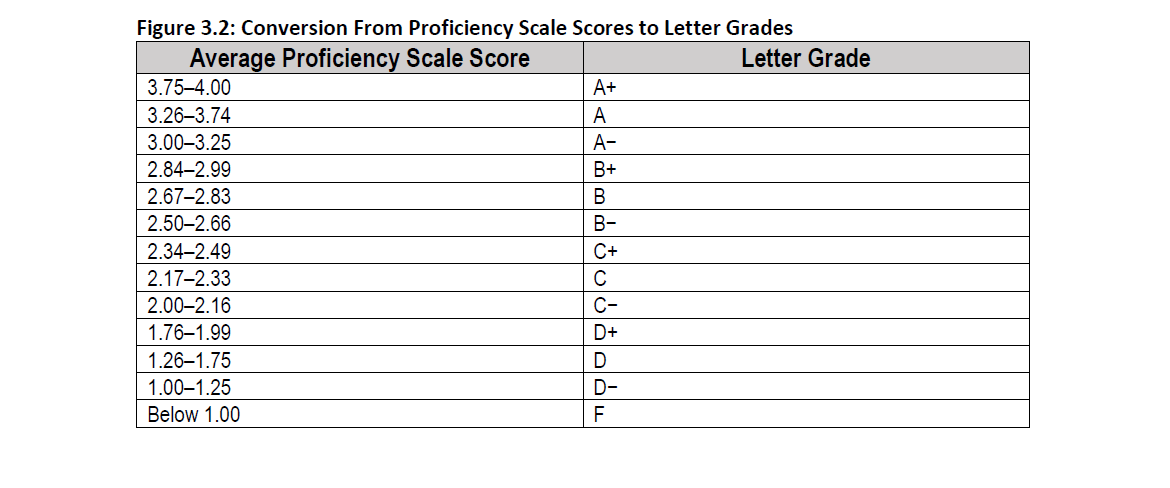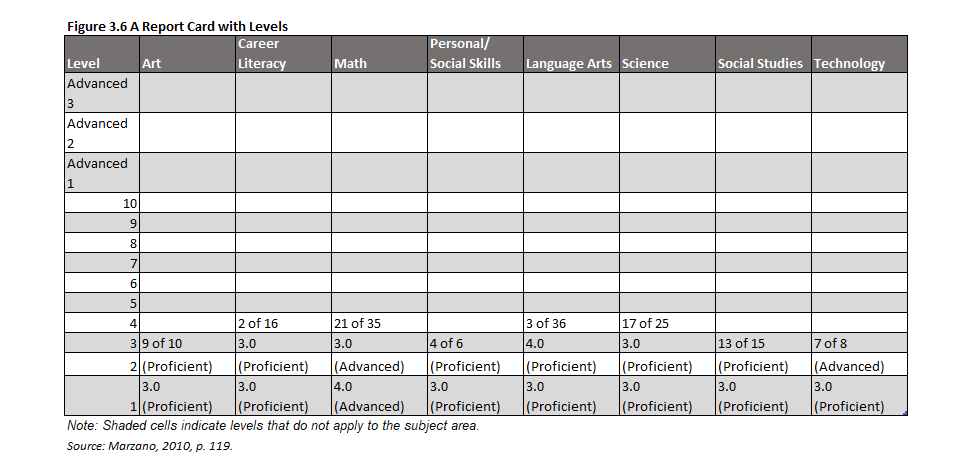Within the Marzano Academy model reporting and grading can take a number of forms. More specifically, an academy has the choice of using standards-referenced reporting or competency-based reporting.
Standards-Referenced Reporting
Standards-referenced reporting retains aspects of traditional grades and incorporates aspects of a competency‐based system. A partial standards‐referenced report card is depicted in figure 3.1.


In figure 3.1 the overall grades have been computed and reported in a traditional manner. This is done by translating the summative scores on measurement topics for a given subject area into a traditional letter grade. To illustrate, consider the final scores for the subject of social studies. The dark portion of each bar graph represents the student’s initial status, while the light portion represents the student’s current status as described by the summative score. For the measurement topic of Using Geographic Tools (Geography), the student started with a score of 1.0 (the dark part of the bar graph) but reached a summative score of 3.0 by the end of the grading period. Thus, the student grew by 2.0 score points. Notice that the report card in figure 3.1 also includes measurement topics for cognitive and metacognitive skills. These are addressed just as academic content is addressed. That is, each subject area reports status and growth for each specific measurement topic.
Summative proficiency scale scores can be converted to letter grades using the conversion scale in figure 3.2.

There is obvious logic to the conversion scale in figure 3.2. A score of 3.0 on a proficiency scale represents proficiency with the content, therefore, an average of 3.0 or above puts a student in the A category. By extension, an average score of 2.50 to 2.99 puts a student in the B category and so on. Figure 3.3 translates proficiency scale scores into percentage scores.

Competency-Based Reporting
Competency-Based reporting uses a different model than standards‐referenced reporting. A competency‐based system uses levels rather than traditional grade levels. A competency‐based system allows students to progress through levels in each subject area according to demonstrated proficiency rather than time. Therefore, scores are reported according to a student’s individual progression through levels rather than according to a time-based grade level or a specific course. This is depicted in figure 3.6.
Note that many subject areas include levels 01 through 10. Level 10 represents mastery of a subject area as would be sufficient for a general high school diploma in a traditional system. However, not all subject areas include 10 levels. For example, art has six levels, technology has seven levels, and personal or social skills has five levels. In other words, each content area has as many or as few levels necessary to describe progression up to high school graduation. An advantage of a competency‐based system is that it allows for levels that exceed high school achievement expectancy. For example, mathematics has three advanced levels, as do language arts and science. Art has one advanced level, and technology has two. This means that a student who is still working on high school proficiency for some levels, may exceed high school proficiency in others. In many cases, students may earn college credit for achieving these advanced levels.
Finally, note that figure 3.6 displays the level a student is currently working on for each subject area, as well as areas in which a student has already demonstrated proficiency. For example, in science, the student is working on level 04. The proportion in the cell is 17/25. Of the twenty-five measurement topics at that level, the student has demonstrated proficiency (an obtained score of at least 3.0 on the scale) on seventeen of the topics. Also, note that at level 03 in science, the student has a recorded score of 3.0. This means that while the student received a 3.0 or higher on all measurement topics, the majority of the scores were 3.0. An alternative to this convention is to report the average score across measurement topics. For example, instead of an overall score of 3.0 for level 02 mathematics, the student might have received a score of 2.68. It is important to note that, in all cases, this average score across measurement topics would always be at least 3.0 before students can move on to the next level (meaning this student would have needed more work to achieve proficiency). Once a student has completed a level, the teacher drops the proportional scores (as seen in the 17/25 cell for level 04 science) and reports only the overall score for the measurement topics of that level.

Empower
The Empower system allows for a wide variety of reporting options for both standards‐
referenced and competency‐based approaches.
Relative to the use of Empower, academy teachers should:
- Decide whether they will a standards‐referenced or a competency-based system.
- Determine the exact format that will be used with “report cards” and how to generate
those reports.





